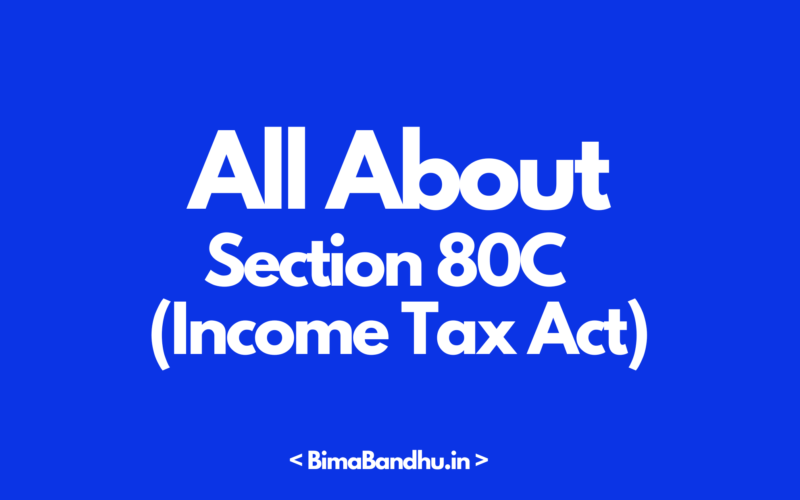Taxes are an inevitable part of our financial lives and often lead us to seek opportunities to save hard-earned money. In India, people look forward to the Income Tax Act, 1961, which provides numerous provisions to taxpayers to reduce their tax liabilities. This Act is a cornerstone of India’s fiscal framework and consists of several sections, each serving a specific purpose. Every section provides various tax-saving avenues, deductions, and exemptions to incentivize responsible financial planning. Among them, Section 80C stands out as a key player, offering an array of options for individuals to reduce their taxable income and enhance their savings.
This comprehensive guide will delve into the specifics of Section 80C, shedding light on the various investment options it encompasses and the criteria that must be met to avail of its benefits. We’ll explore everything from popular investment choices like Public Provident Fund (PPF), Equity-Linked Savings Schemes (ELSS), and National Savings Certificates (NSC), to less-known but equally effective avenues.
What is 80C in the Income Tax Act?
Section 80C is a pivotal provision of the Income Tax Act that offers Indian taxpayers the opportunity to reduce their taxable income. It allows you to claim deductions on the amount you invest in specific financial instruments or expenditures, thereby lowering your taxable income and, consequently, your tax liability.
Some of the key features of Section 80C are as follows:
-
Eligibility
Section 80C is open to individual taxpayers and HUFs. Whether you are working as a salaried employee, a self-employed professional, or a business owner, you can benefit from this section.
-
Maximum deduction limit
The maximum deduction allowed under Section 80C is ₹1.5 lakhs. This means that if you invest up to ₹1.5 lakhs in eligible investments or incur specific expenses covered by this section, you can reduce your taxable income by that amount.
-
Range of eligible investments
Section 80C deductions covers a wide spectrum of financial instruments, including but not limited to:
- Public Provident Fund (PPF)
- Equity-Linked Savings Schemes (ELSS)
- National Savings Certificates (NSC)
- 5-year fixed deposits
- Employee Provident Fund (EPF)
- Tax-saving Fixed Deposits (FDs)
- Life insurance premiums
- Principal repayment of home loans
-
Lock-in period
Many investments under Section 80C come with a lock-in period, which means that your funds are committed for a specified duration. This lock-in period can vary depending on the specific investment.
-
Claiming deductions
To avail of the deductions under 80C, you must ensure that you meet the required criteria for each investment. Additionally, you must retain documentary evidence and receipts of your investments and expenses, which may be needed for tax assessment.
What are the Subsections of Section 80C?
What truly sets Section 80C apart are its subsections that expand the horizon of tax-saving options and allow you to choose investments that best suit your financial goals. The following table provides an overview of the various subsections of Section 80C of the Income Tax Act:
| Section | Eligible Investments and Expenditures | Highlights of the Section |
| Section 80C | – Provident Funds (e.g., EPF, PPF)
– Life Insurance Premiums – Equity Linked Saving Schemes (ELSS) – Principal Sum of Home Loan – Sukanya Samriddhi Yojana (SSY) – National Savings Certificates (NSC) – Senior Citizens Savings Scheme (SCSS) |
Offers a wide range of tax-saving opportunities, covering investments, home loan repayments, and more |
| Section 80CCC | – Payment Made Towards Pension Plans
– Investments in Certain Mutual Funds |
Expands tax-saving horizons by including pension contributions and select mutual fund investments |
| Section 80CCD(1) | – National Pension System (NPS)
– Atal Pension Yojana, etc. |
Rewards investments in government-backed retirement savings schemes |
| Section 80CCD(1B) | Investments up to Rs. 50,000 in NPS | Provides an extra exemption for National Pension System investments |
| Section 80CCD(2) | Employer’s Contribution towards NPS (up to 10% of basic salary and dearness allowance, if any) | Ensures that your employer’s NPS contribution doesn’t add to your tax obligations. |
Section 80C Deductions in Detail
1. Life insurance premiums
One of the key components of Section 80C that allows individuals to reduce their taxable income is life insurance premium payment. Life insurance is a crucial financial safeguard for your loved ones along with being a tax-efficient investment avenue, making it an integral part of your tax-saving strategy.
To get deductions under Section 80C, the policy should be in the name of the individual taxpayer, their spouse, or their children. It is not permissible for the policy to be owned by extended family members or unrelated parties
The maximum deduction limit for Section 80C is ₹1.5 lakhs, and it encompasses all eligible investments and expenditures under Section 80C, including life insurance premiums. Additionally, the maturity proceeds or death benefits from a life insurance policy are often tax-free under Section 10(10D), further enhancing the tax efficiency of life insurance investments.
2. Public Provident Fund
Public Provident Fund (PPF) is a government-backed savings scheme aimed at helping individuals accumulate wealth. One of its notable features is the dual benefit it offers – it fosters disciplined savings and comes with significant tax advantages.
- PPF is open to all individual taxpayers, whether they are salaried employees, self-employed professionals, or business owners.
- Under Section 80C, you can claim deductions of up to ₹1.5 lakhs. This limit covers your investments in PPF along with other eligible financial instruments. The amount you invest in your PPF account is eligible for deductions under Section 80C, reducing your taxable income by the equivalent amount. This helps you save on your annual tax liability.
- PPF investments come with a lock-in period of 15 years. However, the maturity period can be extended in blocks of 5 years post the initial lock-in.
- To keep your PPF account active, you need to deposit a minimum of ₹500 each financial year.
- The interest earned on your PPF account is tax-free, making it an attractive option for long-term wealth accumulation. When your PPF account matures after the lock-in period, the entire maturity amount, including the principal and interest, is exempt from tax.
3. Unit Linked Insurance Plans (ULIPs)
Unit Linked Insurance Plans (ULIPs) combine the benefits of life insurance and investment. They are among the eligible investments that can help you reduce your taxable income, offering the advantage of insurance coverage and the potential for wealth creation. This distinctive blend of insurance and investment makes ULIPs an attractive choice for individuals seeking both protection and long-term financial growth.
- Like PPF, ULIPs are available to individual taxpayers and Hindu Undivided Families (HUFs). You can purchase these policies irrespective of your professional background.
- Under Section 80C, you can claim deductions of up to ₹1.5 lakhs. This limit covers your investments in ULIPs, along with other eligible financial instruments. The premium payments made towards your ULIP are eligible for deductions under Section 80C.
- ULIPs have a mandatory lock-in period of five years, which means your invested funds are committed for at least this duration.
- When your ULIP policy matures, the entire maturity amount is tax-exempt under Section 10(10D). This makes it a tax-efficient way to accumulate wealth over the long term.
4. National Savings Certificate (NSC)
National Savings Certificates or NSCs are government-backed savings instruments designed to provide financial security and attractive returns to investors. They offer a low-risk, long-term investment avenue, making them particularly appealing to individuals seeking stable, tax-efficient savings.
- NSCs are available to individual taxpayers, including salaried employees, self-employed professionals, and business owners. Hindu Undivided Families (HUFs) can also invest in NSCs.
- You can claim 80C deductions of up to ₹1.5 lakhs. This limit includes your investments in NSCs along with other eligible financial instruments.
- NSCs come with a fixed tenure of either 5 years or 10 years, depending on the specific series you choose.
- The interest income earned on NSCs is reinvested and qualifies for a deduction under Section 80C, ensuring that the interest earned is tax-efficient.
- When your NSC matures, the entire maturity amount, including the principal and interest, is not subject to tax at the time of maturity.
5. Employee Provident Fund (EPF)
EPF is a mandatory savings scheme for salaried employees in India. While it primarily serves as a retirement corpus, it also offers tax benefits under Section 80C. You can claim deductions of up to ₹1.5 lakhs. This limit includes your contributions to EPF along with other eligible financial instruments.
EPF also provides tax benefits at maturity. The accumulated amount, including interest, is entirely tax-free.
6. Tax saving Fixed Deposit (FD)
Tax-saving FDS, also known as Tax-Saver FDs, are a particular category of fixed deposits designed to help you save on taxes while providing capital protection. They offer a stable avenue to park your funds, with the added benefit of tax deductions under Section 80C.
These FDs can be availed by salaried employees, self-employed professionals, and business owners. One can claim deductions of up to ₹1.5 lakhs, along with other eligible financial instruments.
- Tax-Saving FDs come with a mandatory lock-in period of five years. This means that the invested funds are inaccessible for withdrawal until the completion of this period.
- The interest income earned on these FDs is subject to taxation at the applicable slab rate.
7. Equity-Linked Savings Scheme (ELSS)
ELSS is a type of mutual funds that invest in equity and equity-related instruments primarily. It offers the opportunity for long-term wealth creation, often outperforming traditional tax-saving instruments, and provides tax benefits under Section 80C.
Under Section 80C, you can claim up to ₹1.5 lakhs. This limit includes your investments in ELSS, and other eligible financial instruments. Besides this, ELSS has a lock-in period of three years, which is significantly shorter than other Section 80C investments like PPF or Tax-Saving Fixed Deposits. On the other hand, the gains on ELSS investments are subject to LTCG tax but remain tax-free up to a specified limit.
8. Senior Citizens Saving Scheme (SCSS)
Senior Citizens Savings Scheme, being a government-backed savings instrument, offers financial security and serves as a tax-efficient avenue for individuals aged 60 and above.
Indian residents aged 60 and above can open an SCSS account and claim deductions of up to ₹1.5 lakhs under 80C. This limit includes your investments in SCSS.
9. Sukanya Samriddhi Yojana (SSY)
Sukanya Samriddhi Yojana (SSY) is a government-backed savings scheme designed to empower parents with a financial tool to secure the future of their girl child. It fosters long-term savings and provides tax-saving benefits under Section 80C.
- Parents or legal guardians can open an account for their girl child.
- Only two SSY accounts are permitted for the same family, irrespective of the number of daughters.
- The scheme is open to all citizens.
- SSY has a lock-in period of 21 years after the account is opened or until the girl child gets married, whichever is earlier.
- Partial withdrawals are allowed for specific purposes, including higher education.
- The interest earned on SSY is tax-free.
10. Principal Repayment on Home Loan
Principal repayment refers to the portion of a loan payment that goes toward repaying the borrowed amount, excluding the interest component. It applies to specific financial products, such as home loans, and the Indian government has provided tax benefits for these repayments under Section 80C.
Under Section 80C, you can claim deductions on the principal repayment of your home loan. The amount you pay towards reducing the borrowed sum for your home purchase is eligible for tax benefits. This encourages individuals to invest in real estate while reducing their tax liabilities.
Eligibility for Section 80C Deductions
Understanding the potential for tax savings under 80C is vital, but it is equally important to know whether you qualify to claim these deductions. Section 80C of the Income Tax Act extends its benefits to both individual taxpayers and Hindu Undivided Families (HUFs). Whether you are a salaried professional, a self-employed individual, or a member of an HUF, you can leverage the 80C deductions offered by this section. However, companies and firms do not fall within the purview of Section 80C.
Latest News Related to Section 80C
Keeping up with the latest developments and changes in tax laws, including those related to Section 80C, is crucial for financial planning. Tax laws are subject to amendments, and staying informed can help you make well-informed decisions to optimize your tax savings.
- Section 80C deduction limit is ₹1.5 lakhs, which includes contributions to various eligible investments and expenditures, such as PPF, EPF, ELSS, NSC, Tax-Saving Fixed Deposits, life insurance premiums, and more. Keep an eye on potential changes to this limit in the annual Union Budget announcements.
- Changes in income tax slabs and rates can have a direct impact on your tax liability and, subsequently, your tax-saving strategies. Be sure to stay updated with any alterations in tax rates, especially for specific income brackets.
- Apart from Section 80C, the Indian Income Tax Act provides other deductions under Section 80, such as Section 80D for health insurance premiums, Section 80E for education loan interest, and Section 80G for donations to charitable organizations. Keep an eye on changes in these sections to optimize your overall tax planning.
- The tax-saving benefits under Section 80C apply primarily to individuals following the old tax regime. Those who have opted for the new tax regime have a different tax structure that does not provide these specific exemptions. When planning your tax-saving strategy, it’s crucial to consider your chosen tax regime and tailor your financial decisions accordingly.
Explore Popular Calculator Guides
| ULIP Calculator |
FAQs
What is covered under Section 80C?
Section 80C of the Income Tax Act covers a wide range of investments and expenditures for tax deductions. These include contributions to instruments like the Public Provident Fund (PPF), Equity Linked Saving Schemes (ELSS), and more.
Is FD covered under 80C deductions?
Yes, tax-saving Fixed FDs are eligible for deductions under Section 80C. The principal amount invested in Tax-Saving FDs is considered for deductions, allowing individuals to reduce their taxable income by up to Rs 1.5 lakhs.
Are donations eligible for deductions under 80C?
Donations to specific funds and charitable organizations qualify for deductions under Section 80G, not Section 80C. Taxpayers can claim deductions on donations made to eligible charitable entities, subject to certain limits and conditions.
What is the Section 80C limit for tax deductions?
The maximum deduction limit under Section 80C is Rs 1.5 lakhs. This limit applies to the total deductions claimed for various eligible investments and expenditures covered by Section 80C. It’s essential to stay updated on any potential changes to this limit in subsequent financial years.
Read BimaBandhu’s Insurance Guides






